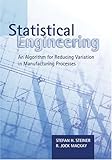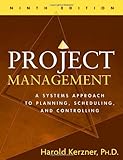Statistical Engineering: An Algorithm for Reducing Variation in Manufacturing Processes
Reducing the variation in process outputs is a key part of process improvement. For mass produced components and assemblies, reducing variation can simultaneously reduce overall cost, improve function and increase customer satisfaction with the product. The authors have structured this book around an algorithm for reducing process variation that they call “Statistical Engineering.” The algorithm is designed to solve chronic problems on existing high to medium volume manufacturing and assembly processes. The fundamental basis for the algorithm is the belief that we will discover cost effective changes to the process that will reduce variation if we increase our knowledge of how and why a process behaves as it does. A key way to increase process knowledge is to learn empirically, that is, to learn by observation and experimentation. The authors discuss in detail a framework for planning and analyzing empirical investigations, known by its acronym QPDAC (Question, Plan, Data, Analys
List Price: $ 98.70
Price: $ 85.22
Project Management: A Systems Approach to Planning, Scheduling, and Controlling
This Ninth Edition of the industry-leading project management “bible” applies its streamlined approach to new, authoritative coverage aligned with the Project Management Institute’s Project Management Body of Knowledge (PMI’s PMBOK), the new mandatory source of training for the Project Management Professional (PMP) Certification Exam. Written by one of the best-known authorities on the subject, this extraordinary edition gives a profound understanding of project management. Content from this book is available as an online continuing professional education course at http://www.wiley.com/WileyCDA/Section/id-320255.html#intro_pm. WileyCPE courses are available on demand, 24 hours a day, and are approved by the American Institute of Architects.
List Price: $ 99.00
Price: $ 37.98
Check This:
 The Lean Six Sigma Pocket Toolbook: A Quick Reference Guide to 100 Tools for Improving Quality and Speed
The Lean Six Sigma Pocket Toolbook: A Quick Reference Guide to 100 Tools for Improving Quality and SpeedA BUSINESSWEEK BESTSELLER Bestselling Lean Six Sigma author Michael George provides the first pocket guide for deployers of Lea…
 The Six Sigma Handbook: The Complete Guide for Greenbelts, Blackbelts, and Managers at All Levels, Revised and Expanded Edition
The Six Sigma Handbook: The Complete Guide for Greenbelts, Blackbelts, and Managers at All Levels, Revised and Expanded EditionThe most comprehensive Six Sigma reference available, now revised and expanded. Completely rewritten and reorganized, this second…
 Six Sigma Workbook For Dummies
Six Sigma Workbook For DummiesImprove your efficiency — and bring in big profits!Need help implementing or understanding Six Sigma? Want to take this powerful …




Best book on Project Management,
This is the best book i’ve ever read on PM. If you are thinking on taking the PMI exam, read this book. If you’re looking for a book to learn PM, read this book. If you’re trying to apply best practices on your PM day to day practice, definitely, read this book.
This book is a classic. I have heard some PMPs quoted and recomended this book.
Was this review helpful to you?

|The most comprehensive PM textbook and excellent study gude for the PMP,
I will have to respectfully disagree with the reviewer who stated this book was not good for preparing for the PMP. Though I will have to admit that this depends on how extensive you want your PMP preparation to be as well as if throughly learning the subject of project management is more important than just passing the PMP. If this is the case, then this book will exceed these expectation on all counts.
On the structure and contents of the text, it has 23 chapters whereupon the first 10 chapters delve into the basic structure and organizational behaviors that create a need for project management. In a sense, these chapter deal with the “soft” issues in project management, since the success of projects depends on the people who work on them and the stakeholders and customers who support and drive the project initiative. As Kerzner states, “these first ten chapters are needed to understand the cultural environment for all projects and systems”. For those preparing for the PMP, chapter 3 titled “Organizational Structures” gives an in depth exposition of the types of organizational structures such as functional, matrix, and projectized that you will need to know for the PMP exam. You can see where much of what is in the chapter no doubt influenced the PMBOK.
Chapters 11-20 go into the heart of project management such as planning, scheduling, cost control, estimating, procurement and quality. These chapter are indeed “hard-core” project management tools and techniques that are systematically discussed in depth. But this is where much of the meat of project management is discussed and where all the major PMP exam subjects are covered. Particularly relevant are these chapters:
11 – Planning
12 – Network Scheduling Techniques
14 – Pricing and Estimating
15 – Cost Control
17 – Risk Management
19 – Contracts and Procurement
20 – Quality Management
I would recommend reading these chapter once through, then answering the questions at the end of the chapters, and going back to sections you were not clear about. Unlike the previous editions, this one has answers for the end of chapter questions and I found them relevant to the study of the PMP exam.
The last 3 chapters are an advanced overview of topics such as developing your own project management methodology, critical chain (which you may get a question or two on), and the Project Management Office (PMO). These chapters can be glanced over or skipped for another time.
I can recall when I took a PMP exam prep class with the PMI LA chapter, that many instructors acknowledged the greatness of this book and the likelihood of learning everything you need to know for the PMP exam if studied exhaustively, but also kept saying what an enormous tome it is at 1000+ pages and the exhaustive technical details of project management laid out, that most recommended not to use the resource unless you had a lot of time and stamina.
Hearing this, I was both intrigued and intimidated when I saw this book at Borders, but after picking it up and skimming it over and reading some sections, I found it quite readable, if a bit text bookish and academic. I will say this though, it is definitely more readable then the PMBOK. I promise!
Consider though that if you read the PMBOK (which many recommend you read several times) and a couple prep books, you have in fact read thousands of pages preparing for the PMP exam.
In all seriousness though, if it is your desire to simply pass the PMP exam and/or your pressed for time, then perhaps it is better to just purchase the PMBOK and Rita’s text (which I did not like at all) and just cram and memorize. There’s nothing wrong with that, as people taking the PMP exam are busy professionals without a lot of time.
But if you are planning to take your time and want to throughly learn the science and art of project management as well as pass the PMP exam with flying colors, then I wholeheartedly recommend this book. One way or another you will be referencing this book if you are a true project management professional.
I utilized this book in my studies for the PMP exam, and was able to pass in the upper 80th percentile and did not need to resort to any form of memorization or cramming, nor did I resort to doing a “brain dump” sheet on the day of the exam.
Happy studies and good luck to all you aspiring PMP project managers!
-Don Kim, PMP
Was this review helpful to you?

|Please see JQT review,
I reviewed this book very favorably for the Journal of Quality Technology in the October 2005 issue. This review is freely available to the public.
I am not allowed to post the URL, but a quick search on ASQ Journal of Quality Technology should get you there.
Bill Woodall
Was this review helpful to you?

|Must read,
This is NOT a typical book on statistical tools. It is a strategy book on how to search for cost-effective changes to reduce variation using empirical means (i.e. observation and experiment). The uniqueness of this book:
(1) Summarizes the seven ways to reduce variation so we know the goal of the data gathering and analysis
(2) Present analysis results using graphs instead of P-value.
(3) It integrates Taguchi, Shainin methods and classical statistical approach.
It is a must read for those who are in the business of reducing variation using data, in particular for the Six Sigma Black Belts and Master Black Belts. Don’t forget to read the solutions to exercises and supplementary materials to each chapter on the enclosed CD-ROM.
Was this review helpful to you?

|